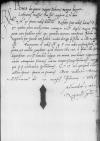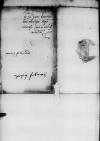Letter #1833
Bona Sforza to Ioannes DANTISCUSPiotrków, 1538-02-07
| received [1538]-02-22 Manuscript sources:
| ||||
Text & apparatus & commentary Plain text Text & commentary Text & apparatus
Reverendissimo paper damaged⌈[Reverendissimo]Reverendissimo paper damaged⌉ in Christo Patri, domino
Reverende in Christo Pater, sincere nobis dilecte.
Redditae sunt nobis cf.
Bene valeat.
Dat(ae) or Dat(um)⌈Dat(ae)Dat(ae) or Dat(um)⌉
Ad mandatum serenissimae maiestatis reginalis proprium


 BCz, 1601, p. 668
BCz, 1601, p. 668